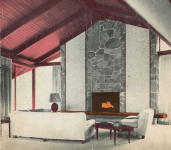where he took bass-reflex alignment tables as starting point
Using ANSYS to simulate what happens inside a vented vrs quarter-wave enclosure (mass loaded voigt). I did a summary.
dave
The old click test is our friend here:
I did pretty version of that for teh A26 document.

dave
I try... God knows, I try. 😉A must read, but his software is very limited. MJK (NLA) is likely best, HornResp is the current standard, there are a couple others. All still need better data on teh effects of damping. My goto tool for quarter-wave (TLs) is Dr Scott (Scottmoose). He has all those tools and some of his own, and, most importantly, vast experience.
http://p10hifi.net/TLS/downloads/AugspurgerAES107rev2.pdf
dave
I like it... The click test returns, in attractive form.I did pretty version of that for teh A26 document.

dave
I use it all the time, even though I've got multiple options for measuring. Worked then, it works now.
I'm curious, how can you listen about the cone control, what are you supposed to be listening?
Better cone control = more accuracy and less distortion
Better cone control = more accuracy and less distortion
And that is how horn loudspeakers work. A horn is an acoustic transformer that matches the motional impedance of the driver to the air impedance. Properly designed this reduces the driver excursion by a factor of ten for a given SPL and significantly reduces distortion.
The downside (apart from difficulty of construction for the amateur) is that for low frequencies the physical size becomes truly heroic.
What do you guys refer to "boxy sound"?
I built a lot of closed speakers in the last years from sub to midrange and never experienced something like "boxy sound". With the right dampening it was always precise and "clean", especially compared to a portet volume. Also for (bass)midrange I always got better results in closed volumes (combined with subwoofers, as I always do, so you can do a real comparison).
So what's this "boxy sound" and what do you do to achieve it?
I built a lot of closed speakers in the last years from sub to midrange and never experienced something like "boxy sound". With the right dampening it was always precise and "clean", especially compared to a portet volume. Also for (bass)midrange I always got better results in closed volumes (combined with subwoofers, as I always do, so you can do a real comparison).
So what's this "boxy sound" and what do you do to achieve it?
These are not small beasts. Or simple to build. Another Nelson Pass moment :
https://www.passdiy.com/pdf/KleinHorn.pdf
https://www.passdiy.com/pdf/KleinHorn.pdf
Indeed. Always worth another look if you like a 'manly' sized speaker. 😉
Wish I had the space. Although TBH if I did, I'd probably do some variation of John Hilliard's built-in 50-ton system. Wonder if it still exists. I think the house on Cowan Heights still does, but goodness knows about the system he designed. Hope so...
Wish I had the space. Although TBH if I did, I'd probably do some variation of John Hilliard's built-in 50-ton system. Wonder if it still exists. I think the house on Cowan Heights still does, but goodness knows about the system he designed. Hope so...
Attachments
Last edited:
Hi, I had quite noticeable "box sound" with ~100l boxes as three way speaker bass, low order crossover somewhere around 200Hz. Boxes were with questionable bracing schemes and insufficient damping. No obvious resonances in driver or port measurements, or with casual listening, but increase SPL to party level and it was quite obvious that there was speaker boxes in the room 😀 I mean, just midrange rumble and noise in a way, not sure what eventually made into it. Quite possibly all the big panels of the box radiated sound, which became obvious as soon as it goes above ambient noise.What do you guys refer to "boxy sound"?
I built a lot of closed speakers in the last years from sub to midrange and never experienced something like "boxy sound". With the right dampening it was always precise and "clean", especially compared to a portet volume. Also for (bass)midrange I always got better results in closed volumes (combined with subwoofers, as I always do, so you can do a real comparison).
So what's this "boxy sound" and what do you do to achieve it?
Unfortunately I did not make measurements that would have tried to find the culprit, or high SPL level measurements in general. I should have taken.
Here is example of knuckle test of another box. The driver itself works as "mic", sensin vibrations from the box while I'm knuckle tapping back panel of the box. This is ~50l closed box with some bracing in but no damping:
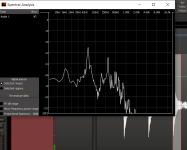
And then the same test, but now there is extra plywood glued with viscoelastic adhesive inside the box making some CLD to the walls, also some 5cm thick insulation as damping on all walls basically:
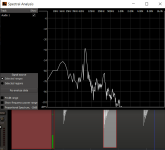
Its not very scientific test, not very controlled or calibrated, but an indication that things got better and not worse 😀
Here is another set of very unscientific test of the box without much bracing yet, empty box with BT speaker playing noise inside of the box and lid on top before hole was cut for driver. With the empty box, sound transmitted quite clearly through, almost like no box at all, well, the lid is not sealed so... Anyway, to give some indication about relative levels, how much damping material affects what comes out from a box.
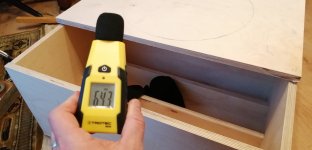
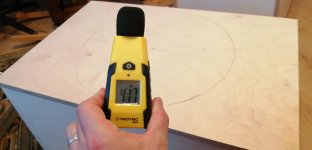
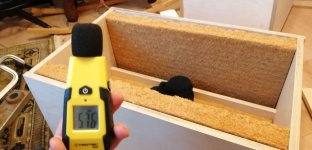

Subjectively, a box can "ruin" midrange performance being nasty unintended sound source in a system radiating sound to various directions with various frequency response, possibly with high Q peaks and so on. Grabs attention from music to an issue, not fun at all 🙂 Subjectively there is quite big difference in "box sound" with more or less effort to dampen it. It's quite obvious that (at least large) box has a sound which can be an issue, but also can be manipulated to be less obvious.
Last edited:
I don't, but I've always assumed it's mostly used as a catch-all description used to refer to enclosure resonance / resonances without being specific about the cause. I'd guess most of the time people are referring to an underdamped [and unintended] standing wave, or a poor / underdamped box alignment (in which case a well-damped TL is already likely to be doing well by default), although in some cases it might even be a panel resonance or diffraction issue.What do you guys refer to "boxy sound"?
Yeah exactly, and very likely many of the issues combined.
ps. here spectral analysis spanning multiple knocks giving some kind of average I think. It shows that effect of my CLD and damping effort was mostly on higher frequencies around 1kHz and up. Very little effect on ~200-300Hz resonance/noise if comparing to system main resonanse around 80Hz. I'm not sure if I should compare to the main resonance or to absolute level, perhaps to absolute level.
Its always the lowest resonance which is least affected with any treatment and needs special care. It's also most within pass band, at least closest to pass band, and its the most problematic one. These analysis indicate I should do something about it, test more, add bracing or something, dampen the peak, it very likely still contributes to a box sound.
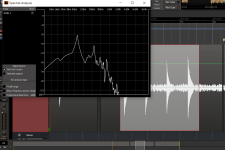
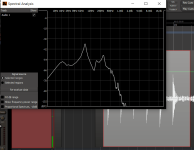
edit.
For completeness here some quick impedance plots, which seem to have some issues as its too high and phase is poop, but perhaps work for comparison between:
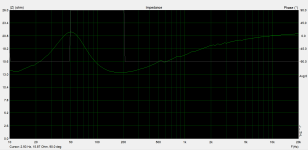
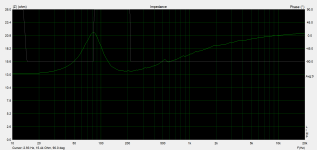
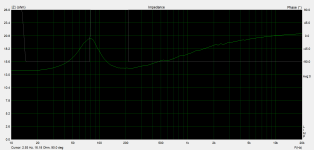
Nearfield and 1m measurement with 5.5ms gate to get any resolution, it could be that the ~300Hz dip is due to room reflection already, or from the box resonance. Anyway, resolution is poor with so short windowing. Levels not calibrated.
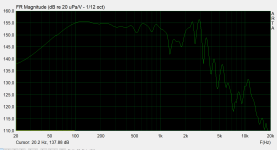

ps. here spectral analysis spanning multiple knocks giving some kind of average I think. It shows that effect of my CLD and damping effort was mostly on higher frequencies around 1kHz and up. Very little effect on ~200-300Hz resonance/noise if comparing to system main resonanse around 80Hz. I'm not sure if I should compare to the main resonance or to absolute level, perhaps to absolute level.
Its always the lowest resonance which is least affected with any treatment and needs special care. It's also most within pass band, at least closest to pass band, and its the most problematic one. These analysis indicate I should do something about it, test more, add bracing or something, dampen the peak, it very likely still contributes to a box sound.


edit.
For completeness here some quick impedance plots, which seem to have some issues as its too high and phase is poop, but perhaps work for comparison between:



Nearfield and 1m measurement with 5.5ms gate to get any resolution, it could be that the ~300Hz dip is due to room reflection already, or from the box resonance. Anyway, resolution is poor with so short windowing. Levels not calibrated.


Last edited:
A serial resonance circuit does wonders for membrane resonances. Or better said THD at lower frequencies.fun begins when you use internal resonance traps to simplify crossover especially for stiff cone midrange
After exporing that recently I will incude these in my future active projects - get the right tools for your problem areas.
Ok - that's understandable. But here was talked about that closed speakers are more prone to that - every reflex housing would have the same problem when constructed that way.Hi, I had quite noticeable "box sound" with ~100l boxes as three way speaker bass, low order crossover somewhere around 200Hz. Boxes were with questionable bracing schemes and insufficient damping.
There is some missconception that a hole in a box "releases" something and helps with that. A proper designed "hole" (=very specific tube) keeps as much higher frequencies IN the box as possible and only works at the resonance frequency. You have the same "boxy" problems with them. And as you should not bring lower frequencies as the resonance frequency to such a ported speaker it also doesn't really help at lower frequencies - cause these are not "there" anyways.
That shows EXACTLY how it should react and the 2 different methodes/goales for box constructing! (and what I measured with my material trials)Here is example of knuckle test of another box. The driver itself works as "mic", sensin vibrations from the box while I'm knuckle tapping back panel of the box. This is ~50l closed box with some bracing in but no damping:
View attachment 1201000
And then the same test, but now there is extra plywood glued with viscoelastic adhesive inside the box making some CLD to the walls, also some 5cm thick insulation as damping on all walls basically:
View attachment 1201001
For damping higher frequencies you need to DAMPEN the walls. Elastic layer + stiff layer is a good way to do so. I also like to glue metal sheets (weight) with a thick layer of elastic floor glue in the box.
To shift the low frequency resonances you need STIFF walls! Bracing from one side to the other. And a lot of them so you only have small eares left which are able to resonante -> high frequencies.
One more argument against 2 way speakers - it's always beneficial to use different building technologies for midrange and low frequency driver.
Back to topic - sealed subwoofers are often small -> to make a stiff box is relatively easy. And it's easy to fill with damping material cause you don't have to take care about a port or line resonance - just dampen it.
Here my last design, I use 6 of these in my home cinema. Just fill the "chambers" with sheep wool, done. You could easily even add more stiffening without compromise in airflow - but that was already fine for my use 🤓
Jeah for sure, box sound plagues all relatively big boxes, relatively big to bandwidth they participate. Reflex box would have the same issues, and in addition could have issues with the port. A TL, perhaps its dimensions help pushing internal modes further out of band, while having stiff structure, no port noise issues and so on, lowest mode(s) as useful output. No wonder it could sound better, doesn't mean any box would sound good on bass, given similar Q on the bass any problems /differences would show up higher up in frequency.
FWIW I bought a stethoscope for listening to panel vibrations in loudspeakers, and the isolation of my record deck. Rather than measure using instruments, actually listening to panel resonances can give an instant impression of where bracing might need to be applied.
- Home
- Loudspeakers
- Multi-Way
- Transmission Line vs. Sealed enclosure

